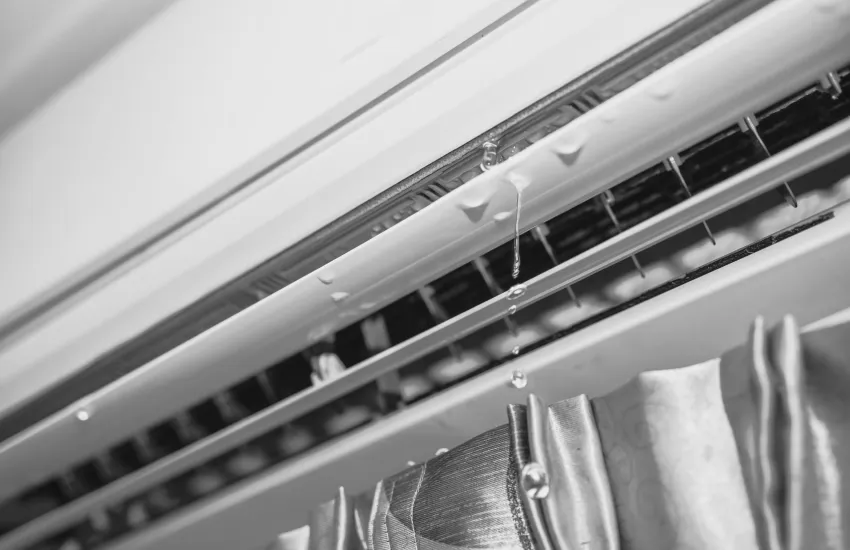7 Expert Solutions for Air Conditioner Water Leaks: | DIY Fixes and Pro Tips

Air conditioner leaking water? This comprehensive guide offers 7 expert solutions to fix the issue, from cleaning drain pans to checking refrigerant levels. Learn DIY repairs and professional tips to keep your AC running smoothly.
7 Expert Solutions for Air Conditioner Water Leaks: DIY Fixes and Pro Tips
Is your air conditioner crying for help? That puddle beneath your AC unit isn’t just an inconvenience; it’s a distress signal.
But we’re about to dive into all the possibilities as to why this would be happening. Read on so you know what to do with yours.
Your fridge is a kitchen superstar as it keeps all your food fresh and drinks cold.
But does the fridge feel warm when you open it?
Is there water all over the floor?
Fridge issues are the worst!
Understanding Air Conditioner Water Leaks
As The AC battles the heat, it naturally produces condensation. Normally, this water quietly exits through a drain line. But when that line gets clogged or other issues arise, your AC transforms into an indoor rain cloud.
Quick Fixes for a Leaking AC
- Power down: Turn off your AC to prevent water damage and electrical hazards.
- Soak it up: Use towels to mop up the leak and prevent further water damage.
- Visual inspection: Look for obvious blockages or damage in visible parts.
7 Expert Solutions For AC Water Leaks
Drain Pan
- Turn off the AC.
- Locate the drain pan under the evaporator coil.
- If you see a lot of water, vacuum it dry and give it a good scrub.
- Cracked pan? A water-resistant sealant might be your temporary savior.
Condensate Drain Line Deep Clean
- Find the PVC drain line near your outdoor unit.
- Get a wire brush and clean any debris.
- Employ a wet/dry vacuum for a few minutes of intense suction.
- Pour a vinegar or bleach solution down the line.
Filter Refresh
- Locate your air filter – it’s probably begging for attention.
- If it looks like it’s been through a dust storm, replace it.
- For reusable filters, treat them to a bath with soap and water.
Evaporator Coil Care
- Locate the evaporator coil.
- Check for ice or grime buildup.
- If dirty, gently clean with a soft brush and coil cleaner.
- Frozen? Let it thaw completely before turning your AC back on.
Installation Investigation
- Ensure your AC unit is tilted slightly for proper drainage.
- Check all drain line connections – they should be snug as a bug.
- If you have a condensate pump, make sure it’s not on strike.
Refrigerant Level Check
- Low refrigerant can cause your evaporator coil to freeze faster than a popsicle.
- This job’s for the pros – call in an HVAC technician to check and recharge if needed.
Condensate Trap Cleanup
- Locate the condensate trap near your indoor unit.
- Remove the cap and clear out any debris.
- Flush it with water or vinegar.

Wrapping It Up
A well-maintained AC doesn’t just prevent leaks; it runs more efficiently, saving you money and keeping you cooler. So why wait for the next leak? Give CLT Appliance Repair a call today for air conditioner repair charlotte nc and let the pros keep your AC running smoothly all summer long.
Don't let a malfunctioning Air conditioner disrupt your daily life. Contact CLT Appliance Repair today at 704-606-9043 to schedule your Air conditioner repair service.
We'll have your fridge back to optimal performance in no time!
- Air Conditioner Not Cooling
- Air Conditioner Leaking Water
- Air Conditioner Making Noise
- Air Conditioner Not Turning On
- Air Conditioner Frozen
- Air Conditioner Sensor Issues
- Air Conditioner Electrical Issues
- Air Conditioner Compressor Problems
- Air Conditioner Thermostat Issues
- Tips for maintaining an air conditioner.
FAQs
Indoor AC leaks are often caused by clogged drain lines, dirty air filters, or frozen evaporator coils. Regular maintenance can prevent these issues.
Clean your AC’s drain line every 3-6 months to prevent clogs. More frequent cleaning may be necessary in humid climates or if you use your AC extensively.
Yes, you can use a diluted bleach solution (1:16 ratio with water) to clean your AC drain line. However, vinegar is a safer, eco-friendly alternative that’s equally effective.
While not immediately dangerous, a leaking AC can lead to water damage, mold growth, and electrical hazards if left unaddressed. It’s best to fix the issue promptly.
Costs vary depending on the cause of the leak. Simple fixes like cleaning a drain line can be DIY, while more complex issues might require professional repair, ranging from $75 to $500.
Appliance Repair Indian Land SC | Appliance Repair Indian Trail NC | Appliance Repair Pineville NC | Appliance Repair Rock Hill SC | Appliance Repair Belmont NC | Appliance Repair Matthews NC | Appliance Repair Lancaster SC | Appliance Repair Cornelius NC | Appliance Repair Fort Mill SC | Appliance Repair Concord NC | Appliance Repair Denver NC | Appliance Repair Monroe NC | Appliance Repair Mooresville NC | Appliance Repair Harrisburg NC | Appliance Repair Lake Wylie SC | Appliance Repair Huntersville NC | Appliance Repair Kannapolis NC | Appliance Repair Mint Hill NC | Appliance Repair Waxhaw NC | Appliance Repair Troutman NC | Appliance Repair Davidson NC | Appliance Repair Gastonia NC | Appliance Repair Charlotte NC

